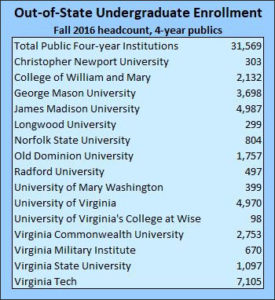
Data source: SCHEV
Tuition at college and graduate school, after scholarships and grants are factored in, increased 1.9% in the 2016-17 academic year across the United States, reports the Wall Street Journal based on data from the U.S. Labor Department. That represented a considerable moderation from the 6% average tuition increases that had prevailed since 1990.
The WSJ analysis suggests that tuition hikes will continue to be restrained as the number of college-age students levels off, families rebel against the high cost of attending college, and competition for students intensifies.
Public Virginia universities increased tuition more aggressively than colleges and universities nationally. The average increase among public Virginia institutions in 2016-2017 was 3.6% — almost double the national average — according to the State Council of Higher Education for Virginia (SCHEV) 2016-27 Tuition & Fees Report. And SCHEV’s preliminary projection for the 2017-18 academic year indicates that tuition increases are accelerating — averaging 4.7%.
(Note: these numbers are not directly comparable to the Labor Department statistics because they do not adjust for scholarships and grants, but they are indicative of trends.)
Bacon’s bottom line: It is unwise to draw hard-and-fast conclusions from only two years’ worth of data. Many factors drive tuition increases, one of the most prominent of which is the level of state support, which fluctuates widely from year to year due to local fiscal and political considerations. But the disconnect between cost increases in the Old Dominion and the nation could spell trouble for Virginia institutions.
Among public four-year institutions in Virginia, competition is greatest for out-of-state students who don’t enjoy the discounted, in-state tuition. Because they pay the full freight, these 32,000 out-of-staters have a wider range of states and colleges to choose from.
Economic reasoning would suggest that the aggressive tuition hikes of Virginia institutions will be reflected in a declining rate of applications and acceptances by out-of-state students. This may not matter for the elite institutions, who have the latitude to pick and choose, but it could impact the second-tier universities. Because out-of-state students pay such high tuition, they subsidize in-state students. Losing even a small percentage of out-of-staters could pose a major financial setback.
The out-of-state enrollment rate at Virginia institutions this fall will be worth watching.


